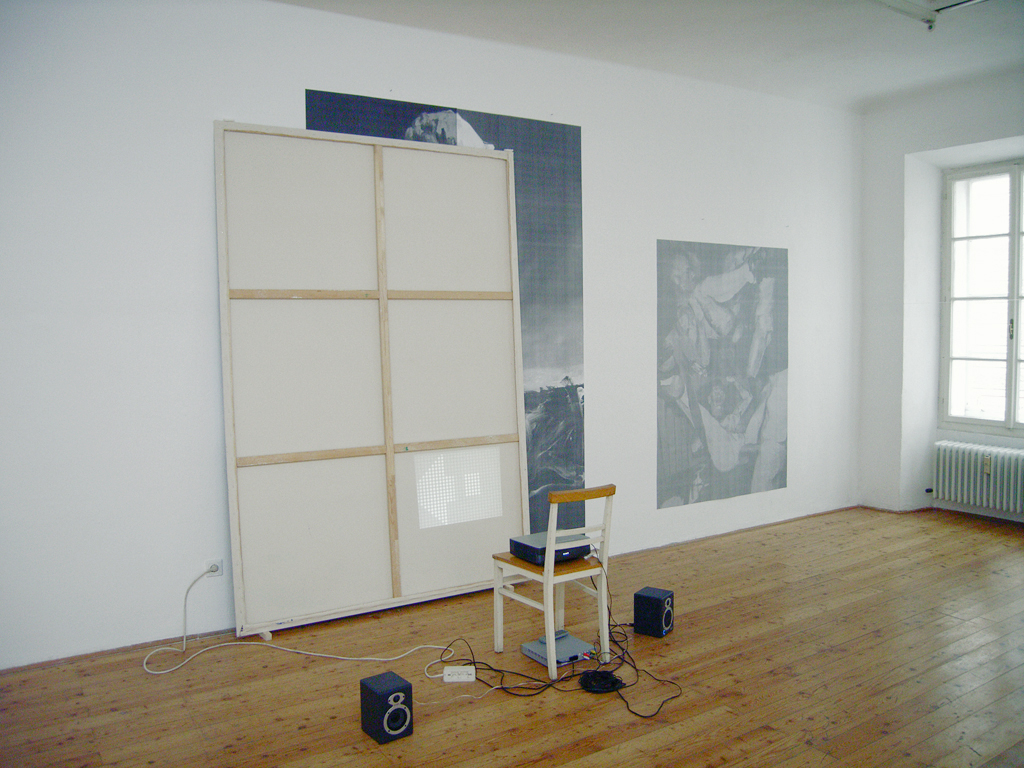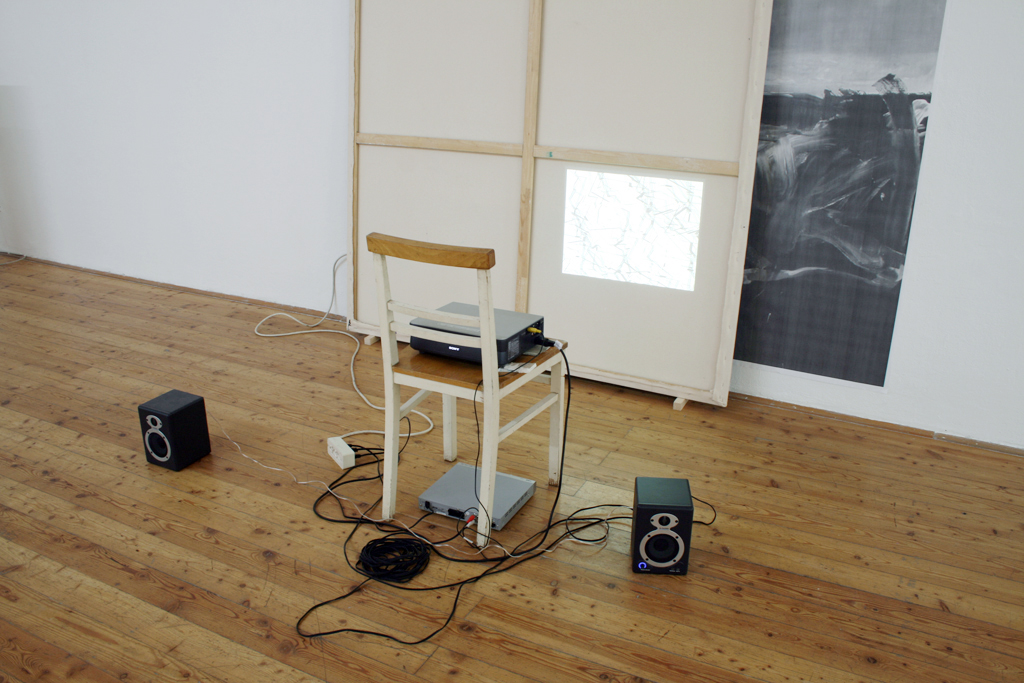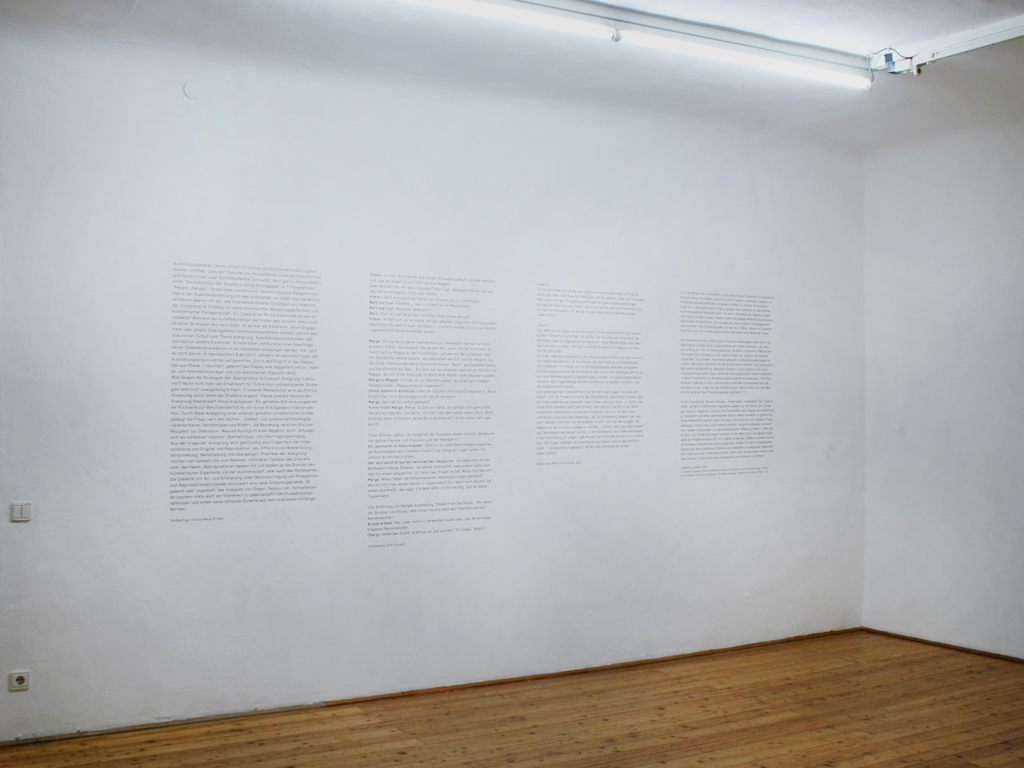It’s All About Art
Video installation: projection, 4 wall texts, chair
Part 1: intervention: the rear side of the canvas (painting by Stefan Heizinger)
is used as projection screen.
Part 2: projection: Frame, void.seqz 5, Rewind, Around and Around
Part 3: 4 wall texts: Situationsbericht

© Exhibition view: Recent Changes - Änderungen vorbehalten, Galerie 5020, A-Salzburg, 2009. Photo: Bernhard Gwiggner
On Annja Krautgasser’s “Seitenwechsel” (Changing Sides)
by Hildegard Fraueneder
Select, arrange, display—the creation of meaning: the exhibition in a dispositif in the sense of a heterogeneous ensemble of the shown and the not-shown, the said and the unsaid, has been frequently addressed in the recent past, and this debate has had a varied impact on both the theoretical and the artistic arenas. Obviously, this focus is better suited than others to see both arenas as belonging together and involved in mutual exchange.
The concept for Recent Changes – Änderungen vorbehalten, a three-part series of exhibitions in which a total of 10 artists participated, pursued an artistic interest shared by both curators as well as addressing the responsibilities of curators and institutions regar-ding the exhibition as a medium: “Position work, positioned—served-up art ...; then delete parts, retain parts ...; then react with different new works, contextual shifts ...; partial deletion again ...; then react again, context renewal ... three layers, increasing density, overlaps, shifts, flowing transitions, ties, transparency, interventions, questioning, commenting, image/theoretical discourse, authorship—curatorship, action—reaction—inter- action ...” (Peter Haas and Bernhard Gwiggner, curators of the exhibition).
Annja Krautgasser was designated to contribute to the second phase of the exhibition so she had to react both to what had been left behind while also leaving something behind herself. Of all the artists’ invited to participate, she placed the act of exhibiting in itself most decisively open to discussion, as the two curators had stipulated or encouraged, in the form of a dialogue-based model: a display that she subjected to a critical reading, with elements providing meaning as well as settings generating atmosphere. She obtained texts from four well-known currently active curators and critics, which she applied as lettering onto the wall of the exhibition space as done in the presentation of paintings. She also installed a blog where she posted texts on the exhibition as a medium while also equally ephemerally projecting a survey of her own video work onto a painted canvas left leaning back to front against a wall following the first phase of the show. In doing so, she was testing the basic parameters of institutionalised exhibition practise by permanently changing sides, from being shown to showing, from being invited to doing the inviting, and so forth—rendering the boundaries and associated hierarchies and interdependencies visible and tangible. In contrast to the, at first glance, open gesture of the exhibition concept which promotes the production of art, Annja Krautgasser reacts by adding a dynamism to the artist’s and the curators’ fields of competence with which she avoids an essential aspect insofar as neither the institution nor the curators, and not even the authors of the texts on the wall, are able to dictate the content of her artwork. They were all involved, appropriated, manoeuvred, and instrumentalised—perhaps without even real- ising it ... What was, what remains? Interventions—which is what the concept of the exhibition called for—are just as unpredictable as they are aimed at finding consensus. At best they open new spaces for thinking or acting here aimed at the well-established mechanisms behind exhibition making. To the extent that Annja Krautgasser deliberately presented her own artwork in the exhibition (i.e. the projected survey of works mentioned above) while also adopting the institutionalised roles by displaying the contributions from those she had invited, she insists on a practise of interruption and of reversal, although positing these conceptually as forms of thinking and action: to pick up on, to continue thinking about, condense, and delete ...


© Exhibition view: Recent Changes - Änderungen vorbehalten, Galerie 5020, A-Salzburg, 2009. Photo: Bernhard Gwiggner
DeutschEnglish
Exhibitions: =werk=42=f15